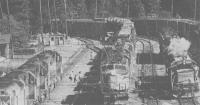|
Between the two electrified sections,
from Avery, Ida., to Othello, Wash., is a relatively flat 210-mile stretch
of track which is not electrified. The “gap,” as it is known, was at one
time scheduled to be electrified, and electric power for it was once
reserved with local suppliers.
The
planners’ intent to electrify the railroad all the way to the Pacific is
also reflected in the present numbering of the substations. Substations
are numbered westward, starting with No. 1 at Two Dot, Mont., and
continuing on the Rocky Mountain Division to No. 14 at Avery, Ida.
Substations 21 through 28 are on the Coast Division between Taunton,
Wash., and Tacoma. The allowed for six numbered stations in the gap were
never built.
The line through the gap, relatively
flat and straight, lacked the immediate operating difficulties of the
other two segments. The gap therefore had the lowest priority for
electrification, since steam power could do the job well.
Shortly after the Coast Division
electrification was completed, the national economy took a downturn. Due
to a resulting lack of traffic development on the extension, a concurrent
difficulty in obtaining capital, and the fact that through passenger and
freight traffic moved over different routes near Spokane, Wash., all plans
for electrifying the gap were dropped by 1921.
Traditionally, the “gap” has posed
several problems, but the primary one has been locomotive utilization.
With electric locomotives restricted to only parts of the 900-mile run
between Harlowton and Tacoma, the railroad has been restricted in its
operational flexibility. Because of the need to improv e
flexibility, conversion to all electric or all diesel on the western lines
has been discussed for many years but neither had been found advantageous
prior to now. Branch line operations on both electrified sections have
always been non-electrified. e
flexibility, conversion to all electric or all diesel on the western lines
has been discussed for many years but neither had been found advantageous
prior to now. Branch line operations on both electrified sections have
always been non-electrified.
|
|
|
The Gap:
Avery, Idaho to
Othello,
Washington
1921
Due to a lack of traffic, plans for electrifying the gap were dropped
Primary
challenge
of the gap
was utilization of locomotives
|
